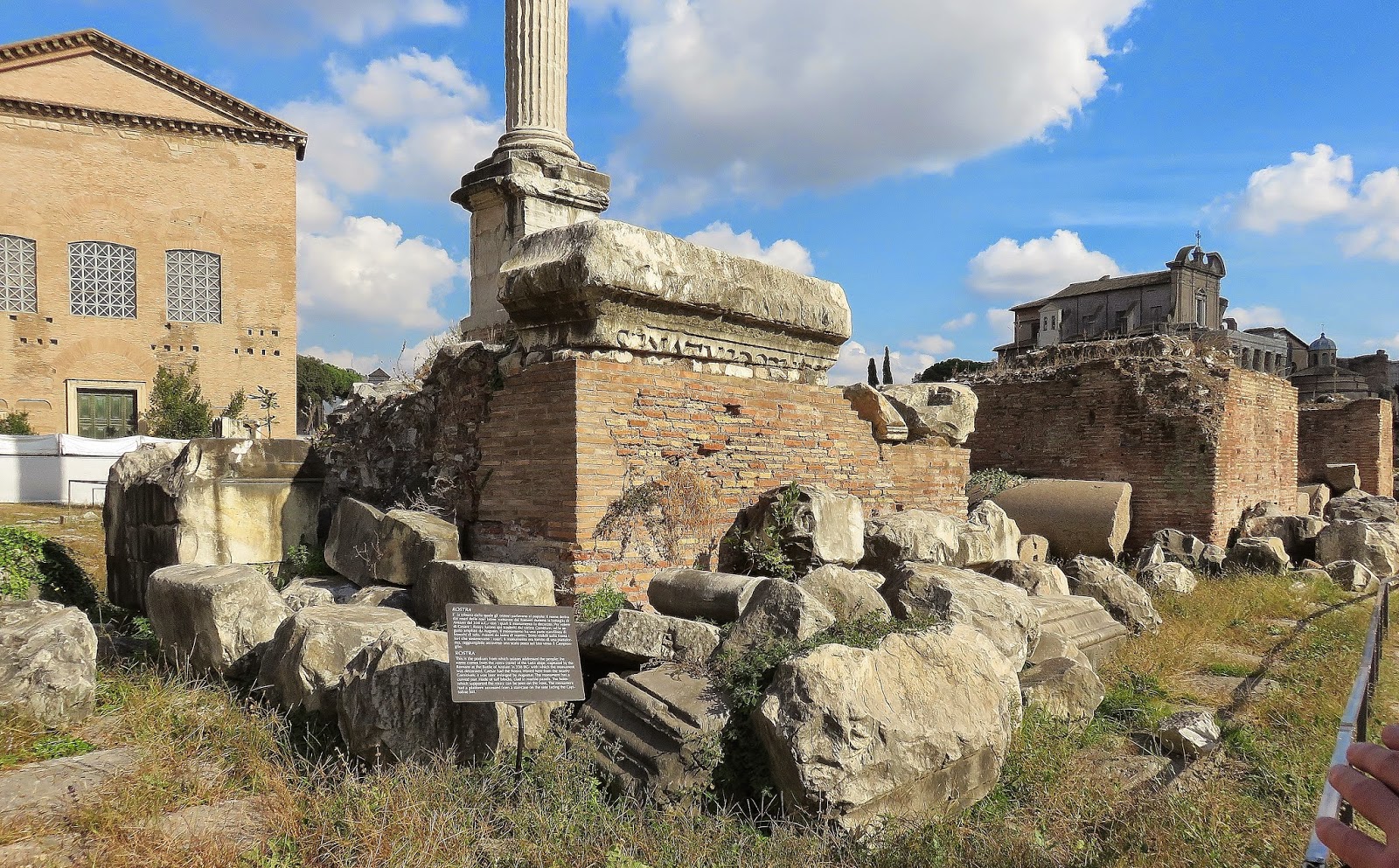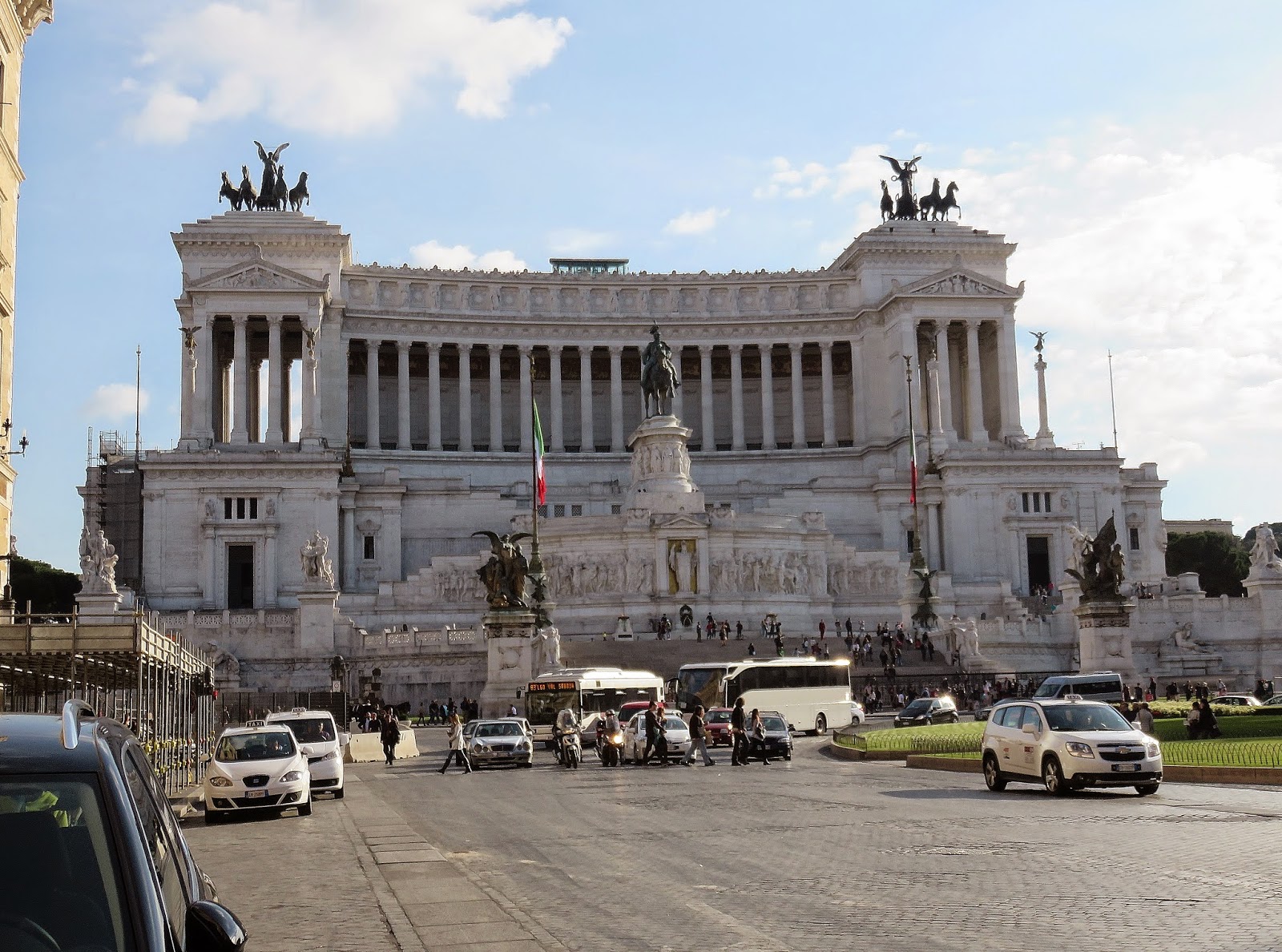It took a while to find it because on the exterior The Basilica of St. Peter in Chains is not very grand, and some of it is covered with the ever present scaffolding.
This church is notable first because of the claim that these are the actual chains Peter wore as a prisoner.
And secondly because this holds what was to be one of Michelangelo's greatest works. In 1505 Pope Julius II hired a young Michelangelo to build his tomb, a huge monument to be placed in St. Peters. Michelangelo selected marble and began working, but then Julius changed his mind and ordered him to paint the Sistine Chapel. That took four years. Then Michelangelo returned to the tomb project and over 30 years worked at in now and then, but when Julius II died, funding petered out and the project was never finished. What was done was placed here in this church.
What we have of Michelangelo's actual work is this statue of Moses
But now we're going back to when St. Peter was actually alive, to what was then the heart of the city, and a dark heart it was, a place of infamy.
The Colosseum was built when the Roman Empire was at its peak, in A.D. 80. It was built for gladiator contests and public spectacles.
When killing became a spectator sport, and the Romans wanted to keep as many people entertained as possible, they built this huge arena.
Under a wooden floor were the passages and chambers for the gladiators, the animals and the props. 80 elevators, worked with ropes, allowed warriors, animals and stage sets to pop up and magically appear.
This is a section of the original marble seats.
A cross now marks the place where the emperor once sat and determined who would live or die.
And yet, despite its cruel history, it is a very cool place to visit.
Outside the Colosseum is the Arch of Constantine, a symbol of the turning of the tide for Rome. In 312 A.D., Constantine defeated his rival, became sole emperor, and legalized Christianity
Leaving the ancient center of entertainment behind, we were off to the business capitol of the empire, the Forum.
The Forum is a rectangular valley running from the Colosseum on the west to Capitoline Hill on the east. Up on the hill to the north is Palatine Hill. We start at the Arch of Titus, commemorating a victory over Judea in 70 A.D.
The rocky path is the Via Sacra, the Sacred Way.
The Basilica of Constantine
The Temple of Antoninus Pius and Faustina (A.D. 138-161), built by the Senate to honor the emperor and his deified wife.
The forum Square was the center of business, culture and government. A million people lived in Rome, and they lived in tiny apartments, mostly just to sleep. Their real living was done in squares of piazzas. In its time this square was teaming with people surrounded by gleaming white marble buildings with 40 foot high columns, rows of statues painted in realistic colors, processions down the Via Sacra, and shops of all kinds.
The Rostra, the podium from which orators addressed the people. Julius Caesar had it erected here. ↓
In fact Julius Ceasar lived here in the Forum and a temple was built here in his honor after his death. He walked these streets on the day he was assassinated, the Ides of March.
The Curia, the Senate House in which he served, in still standing, that nondescript Roman brick building. It was not open for visitors.
We exit the Forum past the Arch of Septimus Severus, A.D. 203
and the Temple of Saturn, the Forum's oldest temple - 497 B.C.
We climb the steps past the Senate to Capitoline Hill. Early on, the Romans provided clean water for filling water bottles.
Capitoline Hill is home to some of the world's oldest museums, from 1471. (They weren't open this day. I think we were relieved) .
Capitoline Hill began in ancient times as a religious center, the site of temples to Jupiter, Juno and Minerva. In the 16th century Michelangelo transformed it from pagan to papal.
Michelangelo's Steps.
Out on the modern streets we swing around the Victor Emmanual Monument, built to honor Italy's first king and to celebrate the 50th anniversary of the country's unification in 1861. We didn't even try to figure out what's in there. We were headed for more ancient history.
Which, of course, was everywhere.
We were on our way to Palatine Hill, overlooking the Forum and the pre-historical birthplace of Rome.
What's here now is the ruins of the Imperial Palace. Augustus, the first Emperor, who followed Julius Ceasar, build a small palace here. Emperor Domitian (81-98 A.d.) later had the royal palace built that would become the home to all future emperors.
The final result was HUGE! The Forum was to the back in this schematic drawing. The Coliseum is in the upper right. The Circus Maximums would have been in the front, below the palace.
But first, there were huts. According to legend, Romulus and Remus were the children of the first Vestual Virgin ( keepers of the eternal flame down in the forum). She was executed and her sons were set adrift on the Tiber River, eventually washing ashore at the base of the Palatine Hill where they were discovered by a shepherd being suckled by a she-wolf. He took them home and raised them. When they grew up Romulus killed Remus, and built a square walled hut here. So Rome began. Archaeological diggings have discovered clues leading many to believe they have found that actual hut, and lending credence to the legend.
In the museum are samples of the marble found in the excavation of the palace site showing what an extravagant place it was.
This "stadium" was actually a formal garden for strolling.
Blue Phlox fill the pools where water and fountains once stood.
That slope in the distance is the far side of the Circus Maximus where chariot racing was held, 12 per day, 240 days of the year. Horses raced here for more than a thousand years. The track dates from 300 B.C. and was in use until 549 A.D., when the church finally disapproved.
The palace included large formal gardens, some of which still remain.
The sun was getting low as we wound back down off the hill and through the Forum.
And back to the Coliseum.






















































Your pictures are so lush snd thoroughly explained, I felt like I was there with you. I can see why you have needed some time to recover from this trip. You didn't waste a moment! :-)
ReplyDeleteWe went to Rome in 1993 and stayed there over a week with the kids and saw all this. We LOVED it too, but my memories have faded. Your magnificent photos just brought it all alive for me again, Linda. Thank you. I'm trying not to visit blogs right now because I'm trying to write my posts, but I couldn't resist. To think we were there only a few weeks apart from you last month. Still, we did not see as much as you did. I loved your photos! OK... now I have to concentrate on my posts.
ReplyDeleteYou should have received quite a few university credits for all you learned here. I've enjoyed following along on your tour.
ReplyDeleteEducational tour, Linda.
ReplyDeleteI have never been to Rome, but many of the images look familiar. Your trip has been quite educational for me to follow.
ReplyDeleteI would have tired of all the ruins...but you guys were troopers either that or you have a great interest in them:)
ReplyDeleteI agree with Red. What a history lesson! The colosseum and the sport of killing is sad to think about. Unbelievable how much there is to see there. I love the pictures!
ReplyDeleteWhat a refresher course in history this has been, sometimes with head nodding, sometimes with brow furled. I would love to spend a month or two there. Thanks for the lovely pictures and detailed explanations.
ReplyDeletePS Loved your thumbs up.
ReplyDelete